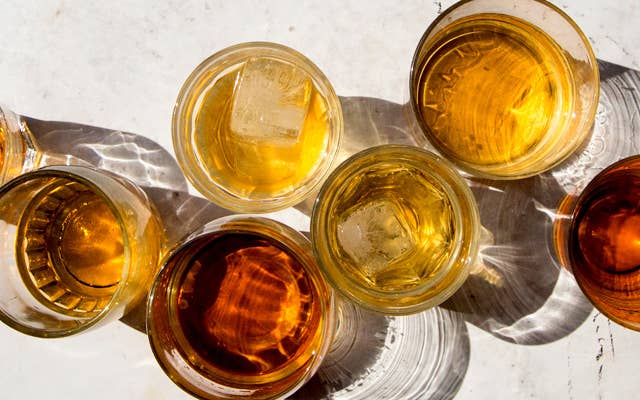
Whisk(e)y can be made anywhere in the world. It’s a spirit distilled from fermented grains like barley, wheat, rye, and corn, and most of it is aged in oak barrels. Definitions differ depending on where you are (in the EU it must be aged to be called whisky, for example) so we’ll take the American view for simplicity’s sake. We won’t cover everything, just hit the high notes.
Spelling
American, Irish whiskey. Scottish, Japanese, Canadian whisky. This is not important.
American Whiskey
Includes bourbon, rye, Tennessee whiskey, corn whiskey, wheat whiskey; and there are a few American single-malts.
Bourbon
Is an American whiskey distilled from mostly fermented corn (plus a smaller percentage of other grains), and nearly always in a big column still. Despite rumors to the contrary, bourbon can be made anywhere in the US, though most is made in Kentucky. Nearly all of it is aged for more than two years, and that aging is done in new charred oak barrels which impart a ton of flavor (vanilla, coconut) and all of the color to the spirit.
Corn Whiskey
Is made from at least 80% corn. Most of the stuff sold as “moonshine” is perfectly legal unaged corn whiskey.
Tennessee Whiskey
For all practical purposes, is Jack Daniel’s and George Dickel. These whiskeys are filtered through charcoal either after distillation or after barrel aging, or both. Other than that, they are pretty much bourbon.
Rye
Is an American whiskey distilled from mostly fermented rye. It is often a little bit spicy (think of rye bread versus corn bread), and is popular in stirred cocktails like the Sazerac and Manhattan. Rye went out of favor for decades, but is now back in a big way.
Scotch Whisky
Is made in Scotland and aged a minimum of three years. Most scotch ages in recycled casks that previously held American whiskey. A few regional flavor shortcuts: “Islay” usually indicates smoky scotch, “Speyside” indicates soft and supple scotch, “Lowland” scotch is light in flavor, and “Highland” scotch whiskies have a greater variance from robust and earthy to pretty and floral.
Single-Malt Scotch Whisky
Is made at a single distillery from only malted barley (not a blend of grains as in American whiskey) and distilled in pot stills. The age on the label is the age of the youngest scotch in the bottle, though there is often some older stuff mixed in.
Blended Scotch Whisky
(Johnnie Walker, Dewar’s, Famous Grouse, etc.) combines single-malt scotch (usually lots of different ones) with more neutral, column-distilled grain scotch whisky. It is lighter and more subtle than single-malt scotch, and also way more affordable and popular.
Japanese Whisky
Mimics scotch whisky for the most part (the guy who created both Yamazaki and Nikka whiskies trained in Scotland), though they prize their blended whiskies just as much as the single-malts. Blended whiskies in Japan are often served in highballs with soda water.
Canadian Whisky
Is most often a light and easy-drinking blended whisky, usually with flavorings and coloring in the mix. Canadians often refer to their whisky as “rye” but that’s their generic term for whisky rather than an indication of rye grains used.
Irish Whiskey
Includes smoky, neutral-tasting, robust, and single-malt variants, but as Tennessee whiskey’s identity is largely defined by Jack Daniel’s, Irish whiskey’s identity is largely understood from Jameson. Jameson is a blend of lighter grain whiskey with heavier “single-pot still” whiskey, and the result is soft and creamy, and a great introduction to aged spirits for those new to the whiskey category.
Whiskey mixology in a nutshell
It all goes great with ginger ale. If you want to get fancy, make that ginger beer instead, consider a squeeze of lemon or lime, maybe add a dash of Angostura bitters, and garnish with a sprig of mint.
Keep Reading
Continue to Next Story










